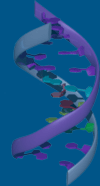Capri DNA page
From Wiki CEINGE
DNA page is the CAPRI default page that allows to analyze nucleic acid sequences like DNA or RNA. User can edit, translate or align its sequences or search within the installed databases. Top menu bar changes if one, two or more sequences are inserted and analyzed at the same time, indicating which tools are available for the analysis.
Contents |
[edit] Functions in single sequence analysis
[edit] Edit
Edit menu allows to manipulate a sequence or to display some informations
- Show: display a sequence with selected features
- Show translated: display only translation
- Reformat: change the sequence format
- Insert: insert a sequence fragment in the given position
- Delete: delete a sequence fragment between the given coordinates
- Replace: replace a sequence fragment between the given coordinates with another chosen by the user
- Remove gaps: remove gaps from the sequence
- Trim ends: remove gaps and "n" only from the sequence ends
[edit] Analyze
Analyze menu allows to compute different sequence values
- GC content: compute the GC percent
- Words: count composition of "words" in a sequence
- Codon usage: chips calculates Nc statistic for the effective number of codons used [1]
- Tm profile: calculate DNA RNA/DNA melting temperature. There is also a graphical representation
- Twisting: calculate the number of turns of a double stranded DNA (or RNA) and other parameters
- Bending, Wobbling: display in a graphical view the calculated bending and wobbling of a sequence
- Isochore: plot isochores in large DNA sequences
[edit] Process
Process menu allows to make some actions on a sequence
- Reverse: give the reverse of a sequence
- Complement: give the reverse complement of a sequence
- Mutagenise: simulate the mutation process of a given sequence[2]
- Add RE sites: add restriction enzyme sites to a given sequence
- Shuffle: make mononucleotide shuffling of a given sequence
[edit] Search
Search menu allows to find feature or particular entities in a given sequence. It is possible to search:
- RE sites (restriction enzyme sites)
- Palindrome
- Tandem repeats
- Inverted repeats
- Pattern. Results can be displayed also in a graphical mode
- Matches from profile
- ORFs (Open reading frames). Results can be displayed also in a graphical mode
- Translated ORFs
- Protein pattern
- CpG islands. Results can be displayed also in a graphical mode
- HLH binding sites.
- TFsites (transcription factors)
- MAR/SAR (matrix/scaffold attachment regions)
- siRNA (silencing RNAs)
- Genes
- Gribskov plot: find genes by comparing codon usage with a codon frequency table
[edit] Extract
Extract menu allows to extract portion of sequence from a given one.
- Fragment(s): extract fragments starting from input coordinates and give a number of sequences.
- Spliced fragments: extract fragments starting from input coordinates, which then were fused in a final sequence simulating a splicing process
- Segments: split the input sequence in a number of overlapping fragments.
[edit] SearchDB
SearchDB menu allows to search in sequence databases which are currently installed at CEINGE. It is possible to search by using:
- Blast
- BlastX
- TBlastX
[edit] Functions in multi sequence analysis
[edit] Draw
Draw menu allows to draw plot which are graphical representation of the regions of similarity between different sequences.
- DotPlot: quick comparison between different sequences
- WordDotPlot: comparison between different sequences based on defined windows
- DothPath: find the (nearly) optimal path aligning two sequences
[edit] Search
- Matches by profile
[edit] Align
Align menu allows to align sequences with the most popular tools like:
- Matcher
- Water
- Strecher
- Needle
- ClustalW
- to an HMM profile. The tool align sequences to an Hidden Markov Model profile.

